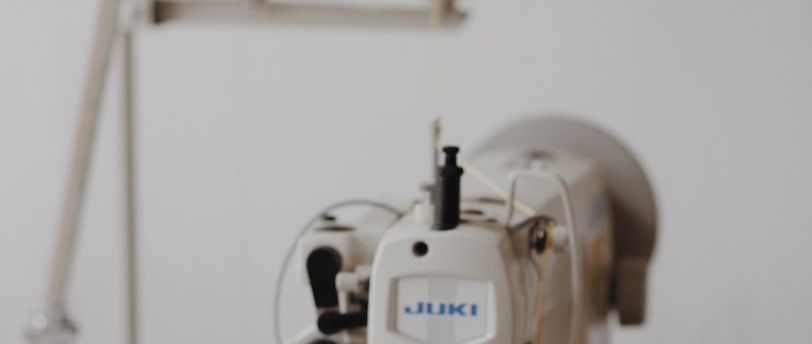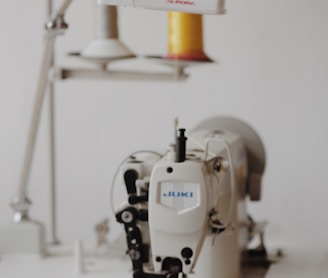Different Types of Sewing Machines
Sewing machines have revolutionized the way we create and mend fabrics. With advancements in technology, a wide variety of sewing machines have been developed to cater to different needs and skill levels.
GARMENTS MANUFACTURING GUIDE
Saleem Shahzad
6/27/20234 min read


Sewing machines have revolutionized the way we create and mend fabrics. With advancements in technology, a wide variety of sewing machines have been developed to cater to different needs and skill levels. In this article, we will explore the different types of sewing machines available in the market today, their features, and their suitability for various sewing projects.
Table of Contents
Basic Mechanical Sewing Machines
Computerized Sewing Machines
Embroidery Sewing Machines
Quilting Sewing Machines
Serger Sewing Machines
Industrial Sewing Machines
Portable Sewing Machines
Overlock Sewing Machines
Handheld Sewing Machines
Heavy-Duty Sewing Machines
Vintage Sewing Machines
Leather Sewing Machines
Buttonhole Sewing Machines
Blind Hem Sewing Machines
Cylinder Bed Sewing Machines
1. Basic Mechanical Sewing Machines
Basic mechanical sewing machines are the traditional models that have been used for decades. They are simple to operate and suitable for beginners or those who prefer a straightforward sewing experience. These machines offer basic stitches such as straight stitch, zigzag stitch, and buttonhole stitch.
2. Computerized Sewing Machines
Computerized sewing machines are equipped with advanced features and are designed for precision and convenience. They have built-in computer systems that allow you to choose and customize a wide range of stitches, patterns, and settings. These machines offer greater control and versatility, making them ideal for experienced sewers and professionals.
3. Embroidery Sewing Machines
Embroidery sewing machines are specifically designed for creating intricate embroidery designs. They have built-in embroidery patterns and features that enable you to embellish fabrics with beautiful designs and motifs. These machines often have a larger embroidery area and multiple thread colors, allowing you to create complex and detailed designs.
4. Quilting Sewing Machines
Quilting sewing machines are specially engineered to handle the unique requirements of quilting projects. They have a longer arm and an extended work table to accommodate larger quilts. These machines offer features like a walking foot, adjustable speed control, and a wide range of quilting stitches, making them perfect for quilting enthusiasts.
5. Serger Sewing Machines
Serger sewing machines, also known as overlock machines, are designed to create professional-looking edges and seams. They can trim, sew, and finish fabric edges in one step, providing a neat and professional finish. Serger machines are commonly used in garment construction and can handle a variety of fabrics, including knits.
6. Industrial Sewing Machines
Industrial sewing machines are heavy-duty machines used in commercial settings. They are built for high-speed sewing and can handle thick and heavy materials. These machines are commonly found in factories and workshops where large-scale sewing is required, such as in the production of garments, upholstery, and leather goods.
7. Portable Sewing Machines
Portable sewing machines are lightweight and compact, making them ideal for sewers who need to travel or attend sewing classes. These machines are smaller in size but still offer a decent range of features and stitches. Portable sewing machines are perfect for quick repairs or small sewing projects on the go.
8. Overlock Sewing Machines
Overlock sewing machines, similar to sergers, are designed to create professional seams and edges. They can trim and sew fabric simultaneously, preventing fraying and providing a clean finish. Overlock machines are commonly used for hemming, seaming, and finishing raw edges in garments.
9. Handheld Sewing Machines
Handheld sewing machines are small, battery-operated devices that allow you to sew without the need for a traditional sewing machine. They are compact, portable, and convenient for minor repairs or stitching in hard-to-reach areas. Handheld sewing machines are not as powerful as regular machines but can be useful for quick fixes.
10. Heavy-Duty Sewing Machines
Heavy-duty sewing machines are built to handle tough fabrics and demanding sewing projects. They are designed for sewing thick materials like denim, canvas, and leather. Heavy-duty machines have a strong motor, durable construction, and specialized features to ensure smooth and reliable stitching even through challenging materials.
11. Vintage Sewing Machines
Vintage sewing machines refer to older models that were produced decades ago. These machines often have a retro charm and are sought after by collectors and enthusiasts. While vintage machines may lack modern features, they can still be functional and are prized for their durability and craftsmanship.
12. Leather Sewing Machines
Leather sewing machines are specifically designed to sew leather and other heavy-duty materials. They have features like a powerful motor, a walking foot, and a longer stitch length to penetrate through thick layers of leather. These machines ensure precise stitching and are commonly used in leathercraft and upholstery projects.
13. Buttonhole Sewing Machines
Buttonhole sewing machines are specialized machines used to create buttonholes in fabrics. They have automatic buttonhole features that can produce consistent and professional buttonholes with ease. These machines offer different buttonhole styles and sizes, providing versatility for garment construction and customization.
14. Blind Hem Sewing Machines
Blind hem sewing machines are designed to create invisible hems on garments. They have a unique stitch that conceals the thread within the fabric, resulting in a seamless and nearly invisible hemline. Blind hem machines are particularly useful for hemming skirts, trousers, and curtains.
15. Cylinder Bed Sewing Machines
Cylinder bed sewing machines have a cylindrical-shaped arm that allows you to sew cylindrical or tubular items with ease. They are commonly used for sewing items like sleeves, cuffs, and bags. Cylinder bed machines provide better access to curved areas and enable precise stitching on rounded projects.
Conclusion
Choosing the right sewing machine depends on your specific sewing needs and skill level. Whether you are a beginner, a professional, or someone who enjoys embroidery, quilting, or garment construction, there is a sewing machine tailored to suit your requirements. By understanding the different types of sewing machines available, you can make an informed decision and embark on your sewing journey with confidence.
FAQs (Frequently Asked Questions)
Q1. Can I use a computerized sewing machine as a beginner?
Absolutely! Many computerized sewing machines offer beginner-friendly features and tutorials to help you get started.
Q2. Are vintage sewing machines still functional?
Yes, vintage sewing machines can still be functional if properly maintained and serviced. However, they may lack modern features and accessories.
Q3. Can a portable sewing machine handle heavy fabrics?
Portable sewing machines are more suitable for lightweight and medium-weight fabrics. Heavy fabrics may require a more powerful machine.
Q4. What is the difference between a serger and an overlock machine?
Both terms are often used interchangeably. An overlock machine is a type of serger that trims and sews fabric simultaneously.
Q5. Can I sew leather using a regular sewing machine?
While it is possible to sew leather using a regular sewing machine, a leather sewing machine is recommended for better results and durability.
